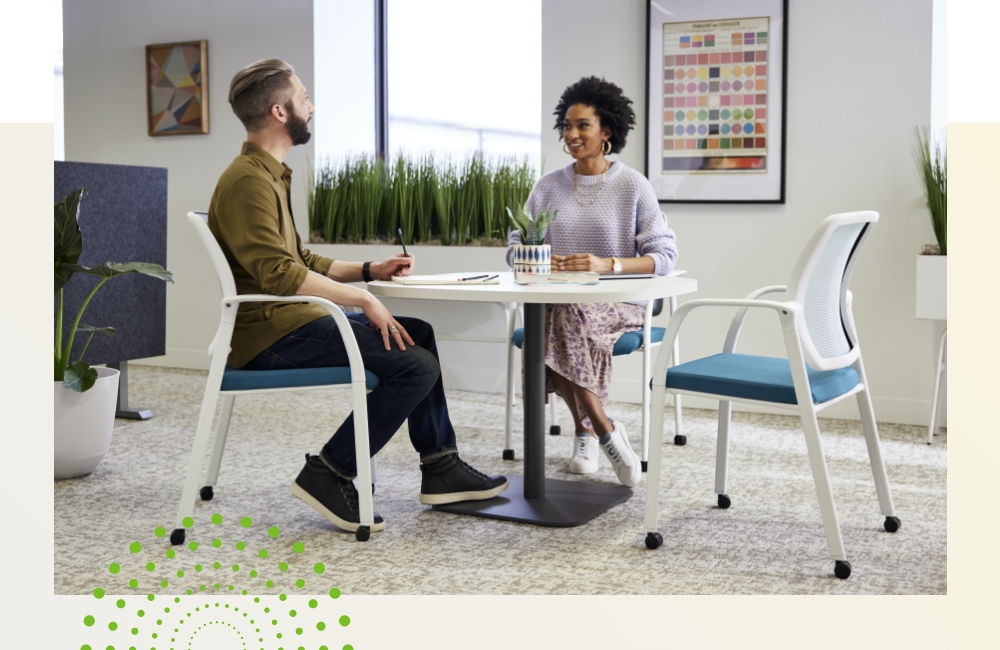Latest From HON
STAY IN TOUCH
Sign up to receive inspirational updates related to product enhancements and the latest workplace trends.

The word “comfort” is a broad catch-all term for anything that makes an environment more conducive to getting things done. But there’s much more to comfort than you might realize. There’s a lot of science behind it, with designers in industries from car design to office environments constantly tweaking and refining details to improve the user’s quality of life.
At HON, we define comfort in three ways: social, psychological and physical. It’s no coincidence these three dimensions are the same used by the World Health Organization to measure health and wellness—and the same prerequisites cited by pediatricians and clinicians as necessary for cognitive development. The connection of comfort to productivity isn’t anecdotal—it matters.
Understanding the inner workings of comfort can make a difference in any work environment. Here are three key considerations.
Featured Product: Nucleus® (Designer White frame coming soon.)
Achieving social comfort is tricky. While some workers enjoy engagement and feedback from peers and managers, others are naturally inclined to remain more insulated. The goal is to help everyone find their balance, but also stretch their proverbial “comfort zone.”
“For a lot of people, the idea of connecting with others creates emotional discomfort,” notes Susan David, a founder of the Harvard/McLean Institute of Coaching. And yet, she says, “discomfort is critical to your growth as a person.” Personal engagement encourages the exchange of ideas and more honest opinions, prevents tunnel vision and can measurably improve employee morale and reduce attrition. Retaining talent is top of mind for every senior leader, and employee engagement can positively impact retention. In fact, a Gallup poll shows it can reduce turnover by up to 43%.
Incorporating informal interactions into everyday activities (beyond typical team building exercises) builds sincere connections, especially among workforces spread across larger campuses and multiple offices.
Change and compromise are challenging for everyone, even in the most dynamic and accommodating office environments. (We’re all creatures of habit, after all.) It’s how we evolve as professionals and get things done—but it can create tension in shared spaces when working together.
A study by the University of Montreal reviewed various facets of work and how they affect employees psychologically. From seemingly minor annoyances to more troubling trends, the takeaway was that psychological comfort positively or negatively affects employees as much as an office that is too loud or too quiet, too hot or too cold.
Reinforcing a sense of belonging, with common goals and shared purpose, all contribute to psychological comfort and help ensure workers feel valued.

Featured Product: Preside® and Nucleus® (Designer White frame coming soon.)
The most obvious form of comfort is physical, from shared considerations like acoustics and climate control to individual ones like the functionality of furnishings. Even remote and hybrid workers soon appreciate the difference between sitting in chairs that were designed for occasional use versus those purposefully designed for use full time.
A survey by office supply company Fellowes revealed one in four workers was uncomfortable at their desk and that their working environment had a negative impact on their productivity. (To learn why design is so important for increasing productivity and lowering absenteeism, read our recent piece on essential workplace chair ergonomics.) At HON, we recognize the individual impact our products have on the comfort of those who use them, as well as the collective impact they have on enterprises of all sizes. That’s why we’ve reimagined one of our most popular products just in time for companies ready to embrace comfort as a key driver of employee satisfaction and performance.
The Nucleus redesign preserves the lauded suspended hammock seat while adding new controls that make subtle seat and arm adjustments feel custom-made for everyone. New colors and customization options offer more versatile options to match any setting. And with HON’s guest chairs and task stools styled to match, physical comfort is possible for everyone in the office—so important for productive workplace engagement.
The benefits of a comfortable workplace—whether working in an office or remotely—both start with a comfortable seat. This was one of the inspirations for the Nucleus® Recharged Task Chair, a seat that seems simple on the surface, but is highly sophisticated underneath its refreshed appearance and function. Notes Marcus Koepke, principal for HON partner Marcus Curtis Design: “The technology used for Nucleus can’t be seen ― it has to be experienced. You just have to sit in [it].”
Whether you’re focused on the social, psychological or physical aspects of comfort — or all three — HON is here to help. We factor all this into our full line of ergonomic furniture and intelligent space design solutions for business, education, healthcare and beyond.
Featured Product: Nucleus® and Workwall
Sign up to receive inspirational updates related to product enhancements and the latest workplace trends.